Exhaustive Search and Backtracking
Recursion Backtracking来自Stanford CS106B Lecture 9/10/11 - Exhaustive Search and Backtracking (winter 2018)的学习笔记。
1. Exhaustive search¶
exhaustive search(穷举搜索): Exploring every possible combination from a set of choices or values.
- often implemented recursively
Applications
- producing all permutations of a set of values
- enumerating all possible names, passwords, etc.
- combinatorics and logic programming.
Often the search space consists of many decisions, each has several available choices.
- Example: When enumerating all 5-letter strings, each of the 5 letters is a decision, and each of those decisions has 26 possible choice.
A general pseudo-code algorithm for exhaustive search:

Example - printAllBinary¶
Write a recursive function printAllBinary that accepts an integer number of digits and prints all binary numbers that have exactly that many digits, in ascending order, one per line.
打印出所有n位二进制数字。使用递归法,注意basecase。
#include <iostream>
#include <string>
using namespace std;
void printAllBinaryHelper(int digits, string s){
if (digits == 0) {
// base case: print the string we have built
cout << s << endl;
}
else{
printAllBinaryHelper(digits -1, s+"0");
printAllBinaryHelper(digits -1, s+"1");
}
}
void printAllBinary(int digits) {
printAllBinaryHelper(digits, "");
}
int main(){
int digits = 3;
printAllBinary(digits);
}
类似的,对于10进制数字,有
#include <iostream>
#include <string>
using namespace std;
void printDecimalHelper(int digits, string s){
if (digits == 0) {
// base case
cout << s << endl;
} else{
for (int i = 0; i< 10; i++)
printDecimalHelper(digits-1, s+to_string(i));
}
}
void printDecimal(int digits){
printDecimalHelper(digits, "");
}
int main(){
printDecimal(2);
}
2. Backtracking¶
backtracking: Finding solution(s) by trying partial solutions and then abandoning them if they are not suitable.
- a "brute force" algorithmic technique (tries all paths)
- often implemented recursively
Applications:
- producing all permutations of a set of values
- parsing languages
- games: anagrams, crosswords, word jumbles
- combinatorics and logic programming
- escaping from a maze
A general pseudo-code algorithm for backtracking
![]()
-
Key tasks:
- Figure out appropriate smallest unit of work (decision)
- Figure out how to enumerate all possible choices/options for it.
Example- Dice Roll Sum¶
Dice Roll Sum: Write a function diceSum that accepts two integer parameters: a number of dice to roll, and a desired sum of all die values. Output all combinations of die values that add up to exactly that sum.
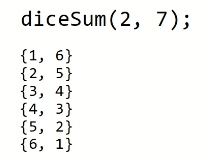
#include <iostream>
#include <string>
#include <vector>
/*
* prints all possible outcomes of rolling the given
* number of six-sided dice that add up to exactly the given
* desired sum, in {#, #, #} format.
*/
using namespace std;
void diceSumHelper(int dice, int desiredSum, vector<int> & chosen){
if (dice == 0) {
if (desiredSum == 0) {
// base case
cout << "{";
for (int i = 0; i < chosen.size() - 1; i++)
cout << chosen[i] << ",";
cout << chosen[chosen.size()-1] << "}" << endl;
}
} else{
for (int i = 1; i < 7; i++){
// choose i
chosen.push_back(i);
// explore what could follow that
diceSumHelper(dice - 1, desiredSum - i, chosen);
// un-choose i
chosen.pop_back();
}
}
}
void diceSum(int dice, int desiredSum){
vector<int> v;
diceSumHelper(dice, desiredSum, v);
}
int main(){
cout << "diceSum:" << endl;
diceSum(3, 7);
return 0;
}
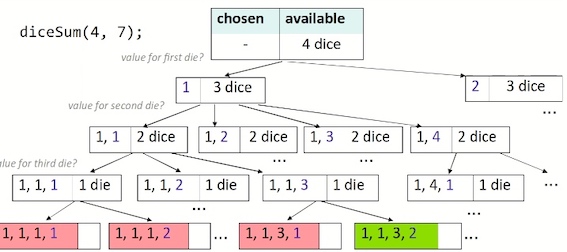
但这并不是非常好的一个解决方案。It checks every possibility. 所以可以加上一些限制条件。
else if (desiredSum >= dice*1 && desiredSum <= dice*6){
...todo something
}
Example - Escape Maze¶
Write a function escapeMaze(maze, row, col) that searches for a path out of a given 2-dimensional maze.
- Return true if able to escape, or false if not.
- "Escaping" means exiting the maze boundaries.
- You can move 1 square at a time in any of the 4 directions
- "Mark" your path along the way.
- "Taint" bad paths that do not work.
- Do not explore the same path twice.

bool escapeMaze(Maze& maze, int row, int col) {
//base case
if(!maze.inBounds(row, col)){
return true;
} else if(maze.isWall(row, col)){
return false;
} else if (maze.isOpen(row, col)){
//choose
maze.mark(row, col);
bool result = escapeMaze(maze, row + 1, col)
|| escapeMaze(maze, row, col + 1)
|| escapeMaze(maze, row, col - 1)
|| escapeMaze(maze, row - 1, col)){
}
//un-choose
if (!result) maze.taint(row, col);
return result;
}
return false;
}
Example - Permute Vector¶
Write a function permute that accepts a Vector of strings as a parameter and outputs all possible rearrangements of the strings in that vector. The arrangements may be output in any order.
- Example: if v contains { "a", "b", "c", "d"}, you function outputs these permutations:
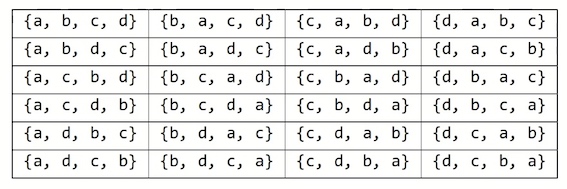
#include <iostream>
#include <string>
#include <vector>
using namespace std;
// {a, b, c, d}
void permuateHelper(vector<string> &v, vector<string>& chosen){
// base_case
if (v.size() == 0) {
cout << "{ ";
for (vector<string>::iterator iter = chosen.begin();
iter != chosen.end(); iter++)
cout << *iter;
cout << " }" << endl;
}
// for each choice:
for (vector<string>::iterator iter = v.begin();
iter != v.end(); iter++} {
//-choose
string s = *iter;
chosen.push_back(*iter);
v.erase(iter);
//-explore
permuateHelper(v, chosen);
//-unchoose
chosen.pop_back();
v.insert(iter, s);
}
}
void permuate(vector<string> &v){
vector<string> chosen;
permuateHelper(v, chosen);
}
int main(){
string str[] = {"M", "A", "R", "T", "Y"};
vector<string> v(str, str+5);
permuate(v);
}
Example: Sublists¶
Write a function sublists that finds every possible sub-list of a given vector. A sub-list of a vector V contains \ge 0 of V^\prime elements.
- Example: if V is {Jane, Bob, Matt, Sara}, then the call of
sublists(V); prints:

- You can print the sub-lists out in any order, one per line.
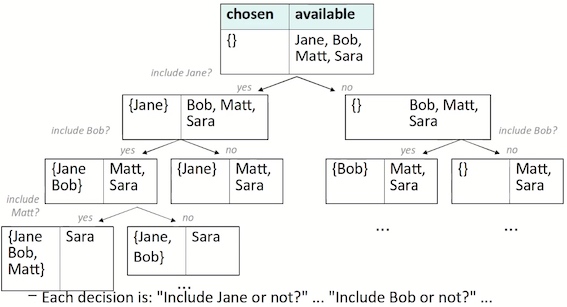
#include <iostream>
#include <string>
#include <vector>
using namespace std;
//{"Jane","Bob", "Matt", "Sara"}
void sublistsHelper(vector<string>& v, vector<string>& chosen){
if (v.size()==0){
// base case
cout << "{";
for (vector<string>::iterator iter= chosen.begin();
iter!= chosen.end(); iter++){
cout << *iter << " ";
}
cout << "}" << endl;
}else{
// recursive case
// for each possible choice:
string s = v[0];
v.erase(v.begin());
// - choose/explore (without s)
sublistsHelper(v, chosen);
// - choose/explore (with s)
chosen.push_back(s);
sublistsHelper(v, chosen);
// - unchoose
v.insert(v.begin(), s);
chosen.pop_back();
}
}
/*
* Prints all subsets of the given vector
*/
void sublists(vector<string> &v){
vector<string> chosen;
sublistsHelper(v, chosen);
}
int main(){
string _names[]= {"Jane","Bob", "Matt", "Sara"};
vector<string> names(_names, _names+4);
cout << "sublists of ";
for ( vector<string>::iterator iter= names.begin();
iter!= names.end(); iter++){
cout << *iter << " ";
}
cout << ":" << endl << endl;
sublists(names);
return 0;
}
Example: 8 Queens¶
The 8 Queens problem: Consider the problem of trying to place 8 queens on a chess board such that no queen can attack another queen.
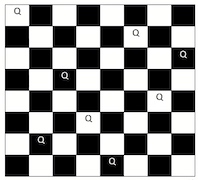
经典的八皇后问题:在8×8格的国际象棋上摆放八个皇后,使其不能互相攻击,即任意两个皇后都不能处于同一行、同一列或同一斜线上,问有多少种摆法。
#include <iostream>
#include <string>
bool solveQueensHelper(Board &board, int column){
if (column >= 8){
// check valid
cout << board.toString() << endl;
return true;
} else {
for (int row = 0; row < 8; row ++){
if (board.isSafe(row, column)){
//choose
board.place(row, column);
//explore
bool finished = solveQueensHelper(board, column + 1);
if (finished) return true;
//unchoose
board.remove(row, column);
}
}
return false
}
}
void solveQueens(Board & board){
solveQueensHelper(board, 0);
}